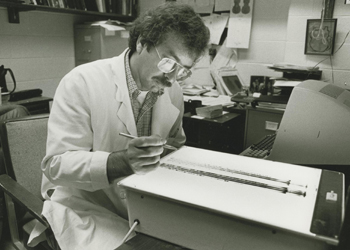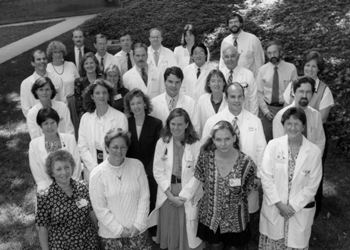Throughout its 4,000-year history, cancer has left doctors, scientists and patients with questions that the medical and science fields could not even start to address until recent decades. For centuries, the question has lingered: Will there be a time when we find a way to control or even cure this disease?

Today, in 2015, researchers and scientists finally understand on a cellular level what cancer actually is and how it spreads and have discovered many successful, targeted ways of treating it – surgically, medically and with radiation.
Almost daily, new discoveries about cancer are made, critical ones like the key to cancer’s spread.
How did we get to this momentous time in the history of cancer? Based on “The Emperor of All Maladies: A Biography of Cancer” and Cancer Progress’ timeline, here are some of the most noteworthy cancer-related achievements and failures.
19th Century
1840s
- “Anesthesia,” the idea of making a patient unaware of pain, was first applied in surgery at Massachusetts General Hospital.
1850s
- After reading multiple similar reports, German researcher Rudolf Virchow published his report about a patient whose autopsy revealed massive amounts of white, milky cells above the red blood upon examination of blood specimens. He named the condition leukemia from the Greek word leukos, meaning white.
- Virchow discovered that cancer was, in its simplest form, the uncontrolled growth of cells, called hyperplasia. This led to the term neoplasia (neo meaning new), a term that is still used today to describe cancer.
1860s
- A Scottish surgeon named Joseph Lister recalled Louis Pasteur’s experiment, which found that meat exposed to air began to ferment. But the air was okay in a sterilized, sealed jar of meat broth. Lister realized bacteria would affect an open wound the same way, so he tried treating an open wound with an antibacterial agent and then closed it. It healed and resulted in another major discovery in the treatment of cancer: infection control.
1890s
- William Stewart Halsted started collecting data on a new procedure for breast cancer, hoping to prove radical mastectomies would prevent cancer recurrence.
- A German lecturer discovered radiant energy that came to be known as X-ray.

20th Century
1900-1910s
- Marie Curie identified radium, named from Latin for light.
- The surgical community discovered that cancer recurrence was determined by whether the cancer had spread prior to a mastectomy, and how far, not by how invasive the surgery was.
1920s -1930s
- Radiation therapy exploded in the United States; the extensive side effects of radium surfaced among workers – both acute, including skin, bone and tooth necrosis, and long-term, including cancers of the blood and sarcomas.
- President Franklin D. Roosevelt approved the establishment of the National Cancer Institute (NCI).
1940s
- Sidney Farber, a pathologist turned clinician researched and tested chemicals (named chemotherapy) that showed promising results in treating childhood leukemia.
- A Greek pathologist named George Papanikolaou invented pap smear tests were invented to prevent cervical cancer.
- Cancer became highly publicized and politicized – finally a topic of international discussion, resulting in abundant funding for research.
1950s
- Farber raised more than $150,000 for his own treatment center for leukemia patients.
- Combination chemotherapy for leukemia showed promise but had limitations.
- The U.S. Senate authorized the NCI to initiate a coordinated effort on the research of chemotherapy drugs, called the Cancer Chemotherapy National Service Center (CCNSC).
1960s
- A four-drug regimen to treat leukemia showed grossly toxic effects in trial populations. However, it could put patients in remission if they survived the side effects.
- Results based on St. Jude’s and other research tests proved chemotherapy regimens could cure 80 percent of those treated.
- Based on numerous studies dating back to the early 1900s and data published by the American Cancer Society, the Surgeon General issued a report linking cigarette smoking to cancer.

1970s
- President Nixon signed the National Cancer Act and funds were poured into the trials of new chemicals for cancer treatment.
- The NCI designated 20 Comprehensive Cancer Centers, hospitals with dedicated cancer centers
- Radioactive seeds for internal radiation were used for prostate cancer and other cancers (Brachytherapy).
- Genes reemerged as the focus for researchers studying cancer.
1980s
- Researchers identified the roles of oncogenes and antibodies, and started using them as targeted cancer treatments.
- Advances in breast cancer research included the successful use of the hormonal drug Tamoxifen to achieve remission with little side effects.
- Doctors began initiating palliative care for many untreatable cancers, using opiates to reduce pain and anti-nausea drugs to relieve vomiting.
- Hospice care was established at hospitals around the world.
- H. pylori infection was found to be a cause of gastric cancer.
- Many hospitals began performing bone marrow transplants.
1990s
- Herceptin was proven a successful drug for breast cancer.
- Early detection and prevention showed promise, but data showed confusing and conflicting mortality rates both across ages and by cancer type. No conclusions could be determined except that there was a great deal still to be learned about cancer.
21st Century
2000s
- Historical medicine and research paired with modern science started to show an impact in the mortality rates of cancer.
- 24 new cancer drugs were brought to market.
- Targeted therapies showed promise but were not reliable.
- Researchers shifted back to the focus on prevention and underlying causes of cancer.
- The Human Genome Project (sequencing of the normal human genome) was complete, allowing the sequencing of gene mutations for cancer types to be studied. By 2009, researchers revealed mutations in pancreatic, ovarian, and lung cancer and leukemia.
2010s
- Major strides have been made in the areas of immunology, metabolism, gene regulation, and cancer metastasis.
- Clinical trials for targeted cancer treatments are available worldwide and offer opportunity for patients to benefit and for researchers to forge ahead in finding a cure based on what proves to be effective.
- Procedures such as “image-guided intraoperative radiotherapy” (only available at UVA Cancer Center) allow patients with early stage breast cancer to have surgery and radiation in a single visit.
- The relatively new combination of imaging, radiology and surgery results in treatment options that are more convenient and effective and less expensive and invasive.
- Cancer survival rates have dramatically increased due to early detection through screening programs, preventative measures and advanced treatment options.
- There are now 68 NCI-designated cancer centers; UVA Cancer Center is one of them.


Fascinating!